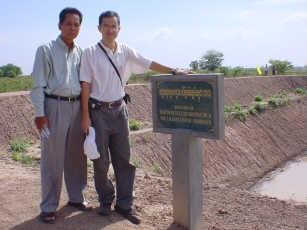Water for Life - We need your support!
Virtually no province of Cambodia, including coastal areas, is spared by the months of drought which may at times, extend from March to July. Some 95% of Cambodians have no access to potable water. Water shortages are widespread during the dry season, forcing households to walk several kilometres for water, to use contaminated water sources and to reduce their water consumption below recommended health levels.
How can a country experience water shortages, when it is home to the largest lake in Asia (Lake Tonle Sap, a water body of 10,000 km2 at the height of the wet season), and when it is yearly flooded by the Mekong and its tributaries? There is little doubt that Cambodia has ample water resources. However, for rural people, the problem is to harvest water and to use it in a sustainable manner, not only for basic household consumption, but also for agriculture.
Historically, Cambodian settlements have clustered along river courses and lakes. Villages located away from rivers generally have community reservoirs, bengs, and ponds, trapeangs. Most pagodas have at least one reservoir for village use. These ponds and reservoirs are replenished yearly by floods and rainfall, and are essential to the continuation of village life during the dry season. In the ancient capital of Angkor, in addition to bengs and trapeangs, the Khmer built a complex hydrological system centered around vast elevated water reservoirs, the barays. These barays, some of which are still operational in Siem Reap Province, are supplied in water by rivers.
At CRCD, we like to presumptuously think that our "Water for Life" projects are the modern-day equivalents of the famed Angkorian barays, albeit on a much, much, smaller scale. Our "micro-barays", a traditional Khmer reservoir surrounded by an elevated dike, is built according to simple modern engineering principles, and uses village social capital and goodwill as its cement. With an average water storage capacity of 5000 m3 (this compares to a capacity of 50 million m3 for Angkor's Western Baray, which is enough for a thousand people to withstand the dry season, these sturdy water structures become an essential component of village life.
CRCD's micro-barays give hope to areas where no development organisation has gone before. Entirely funded by private donations, built by villagers with the support of local craftsmen and CRCD's researchers, micro-barays are more than a source of water; they are a social gathering point, a collective endeavour that promises better days.
CRCD/Camdev Waterworks Characteristics
| Dimensions | Construction Time | Cost | Maximum Support | |
| Reservoir | 30x40m - 5000 m3 | 3-5 months | US $5000 - $6000 | 1000 people |
| Combination Well | 10m culvert - 40m tube depth | 10-20 days | US $400 - $600 | 50 people |
Your support will make a crucial difference. A simple international wire transfer, will ensure that your donation goes directly to our water for life projects, whether for a reservoir or a pond. At CRCD, we believe that great ideas, and of course dollars, can make a big difference. Simple, efficient, useful, beautiful. We didn't need our PhDs to help good people, although they come in handy for report writing.
Provide the funds, and we shall build it!
About CRCD | Research | Publications | Water| Mushrooms | Donate |
© The Cambodian Research Centre for Development (CRCD/Camdev)
Post Office Box 2515, Phnom Penh, Kingdom of Cambodia




